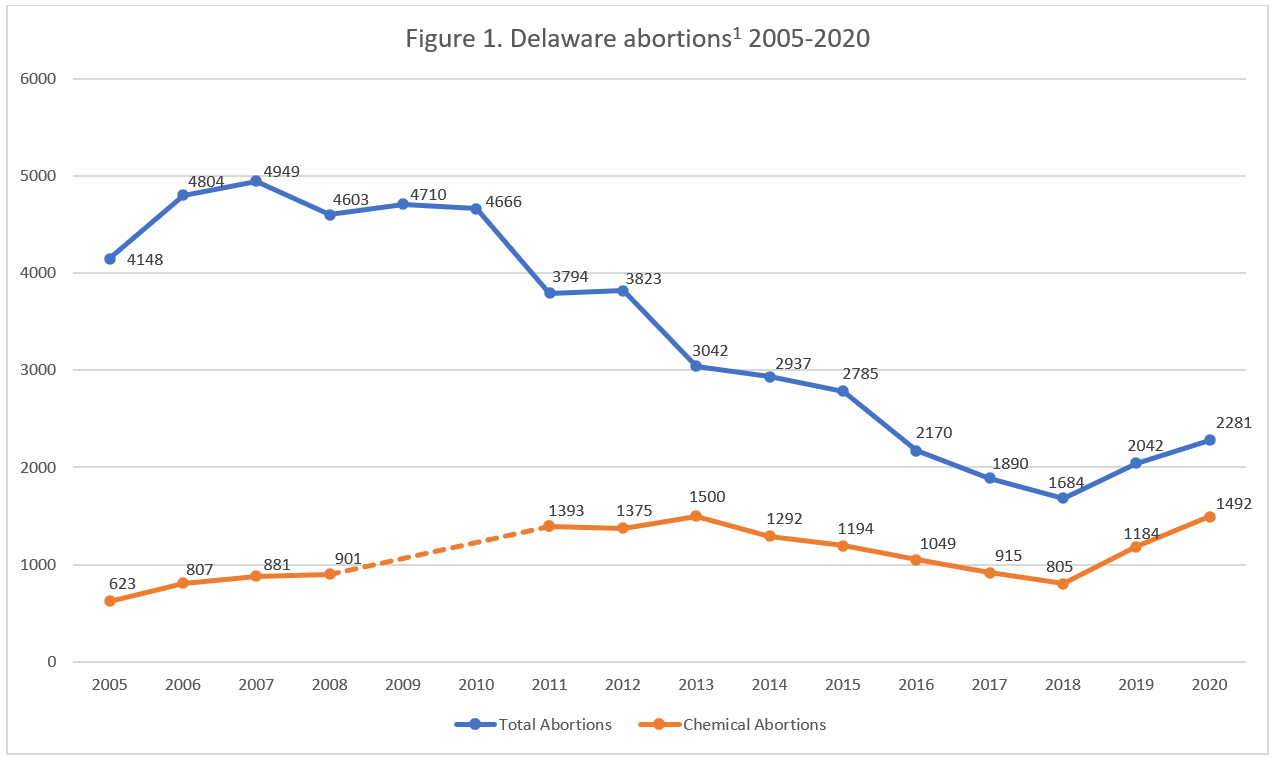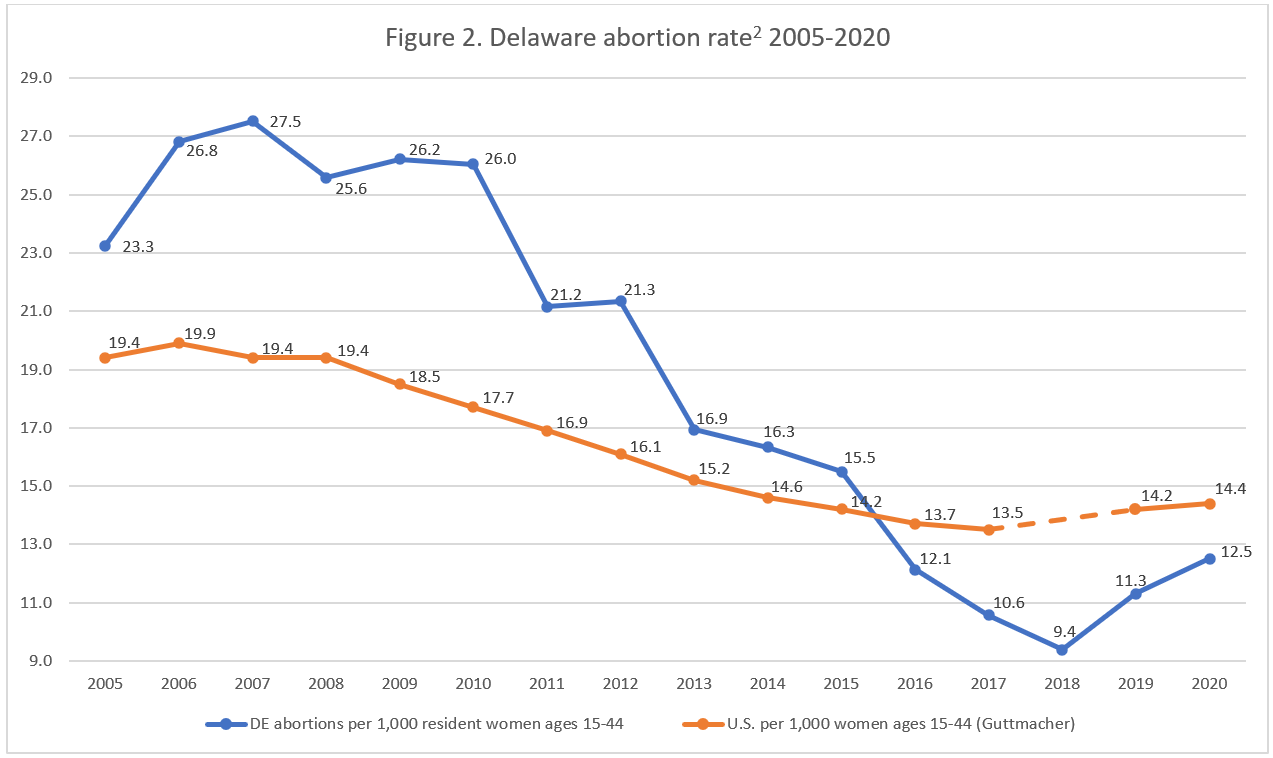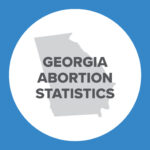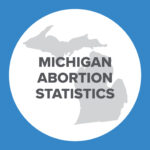Abortion Reporting: Delaware (2020)
Delaware’s 2020 abortion report was published online by the Delaware Department of Health and Social Services. The report shows that abortions increased in 2020 from 2019.
Statistics and Changes in Delaware Abortions, 2019-2020

The report does not include information on Planned Parenthood’s Delaware abortion market share.
Abortion Totals and Trends
There were 2,281 abortions reported in Delaware in 2020, an increase of 12 percent from 2019. Chemical abortions jumped by 26 percent to 1,492 in 2020, making up 65 percent of all abortions reported in Delaware (Fig. 1). The Charlotte Lozier Institute (CLI) estimates that Delaware’s abortion rate was 12.5 abortions per 1,000 women ages 15 to 44, still under the national rate for 2020 (14.4), but up 11 percent from the previous year (Fig. 2). As of October 2022, 36 states have released 2020 abortion statistics, of which 23 showed that abortions had increased from 2019.
State Report Summary
In 2020, 88 percent of Delaware abortions were performed on state residents. Six percent were performed on Maryland women, four percent on Pennsylvania women, and two percent on New Jersey women. Less than one percent were performed on women from other states.
Twenty percent of the abortions reported in Delaware were performed on girls younger than age 20, a larger percentage than in many other states. This includes three percent of girls under the age of 18. Twenty-nine percent of the abortions were on women in their early twenties, and 28 percent on women in their later twenties. Twenty-nine percent of the abortions were obtained by women ages 30 to 39, and three percent were performed on women ages 40 and older.
Just over half of Delaware abortions (51 percent) were performed on black women, even though black women composed just 29 percent of Delaware’s population of women ages 15 to 44. Forty-seven percent were performed on white women. Two percent of the abortions were obtained by Asian women. There were nine abortions on American Indian women (0.4 percent) and six abortions (0.3 percent) on women of other races. CLI estimates that Delaware’s black abortion rate was 22.1 abortions per 1,000 women of childbearing age, almost two and a half times the white abortion rate of 9.1. Fourteen percent of the abortions were performed on Hispanic women, and 86 percent were on non-Hispanic women. The Hispanic abortion rate (14.4) was higher than the non-Hispanic abortion rate (12.3), higher than the state’s overall abortion rate of 12.5, and on par with the 2020 national abortion rate of 14.4.
Eight percent of Delaware abortions were obtained by women who had not graduated from high school. Forty-nine percent were performed on high school graduates, and just over a quarter (27 percent) were on women who had completed one to three years of college. Fourteen percent of the abortions were performed on women with four or more years of college. Education was unreported for three percent of abortions.
Thirteen percent of the abortions reported in 2020 were on married women, and 87 percent were on unmarried women. Seventy-two percent of the abortions were performed on women who had previous pregnancies, while 28 percent were on women who had no previous pregnancies. Forty percent of the abortions were obtained by women with no previous live births, compared to just over a quarter (26 percent) on women with one live birth and just over a third (35 percent) on women with two or more live births. Sixty-one percent of the abortions were on women who reported zero prior abortions. Twenty-three percent were performed on women with one prior abortion, and 16 percent were on women with more than one previous abortion.
A majority of the abortions reported in Delaware (65 percent) were chemical, and 34 percent were suction curettage procedures. There were seven other unspecified abortion procedures in 2020, while the type of procedure was not reported for 14 of the abortions. Twenty-eight percent of the abortions occurred earlier than seven weeks gestation, and 42 percent were performed between seven and eight weeks. Seventeen percent were reported between nine and 10 weeks, seven percent occurred between 11 and 12 weeks, and six percent were reported from 13 to 15 weeks of gestation. Just under one percent (0.7 percent) were performed between 16 and 20 weeks. There were six abortions (0.3 percent) at 21 weeks of gestation or later, and another six abortions performed at unknown gestational time periods.
State Ranking
In CLI’s 2016 paper on abortion reporting across the United States, Delaware’s reporting was tied for 36th best. Since Delaware abortion centers have operated in unsafe conditions in the past, Delaware could collect and report data on complications resulting from abortion. Delaware could also report the percentage of abortions performed at each facility in the state.


- Delaware did not report the number of chemical abortions performed in 2009 and 2010 in its state reports or in the data it shared with the CDC.
- Rates were calculated by CLI using the following formula: (total number of abortions performed in Delaware ÷ number of resident women ages 15-44) x 1,000. Rates may differ slightly from previous CLI articles due to revised population estimates. Population estimates were obtained from the CDC WONDER database. Estimates for 2005-2009 are intercensal estimates of the July 1 resident population. Estimates for 2010-2020 are Vintage 2020 postcensal estimates of the July 1 resident population. Estimates were produced by the U.S. Census Bureau and the National Center for Health Statistics.

























